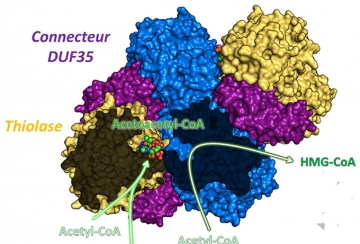Bienvenue à PROXIMA 2A !
Une lumière pour la biologie et la micro-cristallographie.

PROXIMA 2A (PX2-A) est une ligne de lumière micro-foyer-X dédiée à la bio-cristallographie et aux innovations méthodologiques pour les microfaisceaux-X. Ouvert depuis 2013, les sujets traités vont au delà de la cristallographie standard des protéines et incluent la découvert des médicaments, la résolution de protéines membranaires, la virologie, la cristallographie des petites molécules, la diffraction-X des poudres et même la cristallurie. La ligne de lumière est extrêmement automatisée et conçue pour aider les scientifiques à s’attaquer aux cibles structuraux et aux systèmes biologiques les plus exigeants. L’énergie des rayons-X est facilement accordable sur une grande gamme (6 – 18 keV) et rend la plupart des seuils d’absorption accessibles pour des expériences en diffraction-X anomale. La station expérimentale est équipée d’un passeur d’échantillon de haute capacité (148 ports d’échantillon du type SPINE), un goniomètre-kappa de haute performance, un détecteur de fluorescence-X (KETEK) et un grand détecteur-bidimensionnel rapide de faible bruit et compteur de photons unique - l’EIGER X 9M (dont 238 images par second en mode 9M ou 750 images par second en mode 4M).
Voir aussi Biologie Santé : HelioBio
L'équipe
Nos derniers tweets
Offres d'emploi
Contacter William SHEPARD pour plus d'information.
Données techniques
6 - 18 keV
~0.0002 (Si 111)
Two U24 canted undulators (4.5 mrad)
White beam – depends on undulator settings
Cryogenically cooled channel cut crystal monochromator, a convex prefocussing mirror and a Kirkpatrick-Baez pair of focussing mirrors
Linear
EIGER X 9M area detector for X-ray diffraction images (238 fps in 9M mode, 750 fps in 4M mode)
Ketek SDD detector for X-ray fluorescence scans
Diamond scCVD and Ti foil XBPMs
High resolution X-ray camera (SOLEIL in-house design)
Thématiques scientifiques
| Micro-crystallography |
Small and weakly diffracting crystals |
|---|---|
| SAD and MAD phasing |
Phasing with a range of heavy atoms, including sulphur |
| Plate screening |
Screening of crystallization trays |
En recherche interne à SOLEIL, la ligne de lumière PROXIMA-2A est rattachée à la section scientifique :
| Section scientifique SOLEIL | Biologie, santé, Héliobio |
|---|
Before visiting PX2-A
Please contact your LC before departing your lab.
- How many samples?
- Which X-ray wavelengths or heavy atom derivatives?
Sending dewars
Dewars should be sent to your Local Contact (one of the people below):
- Willima SHEPARD (Beamline Responsable)
- Lidia CICCONE
- Martin SAVKO
SOLEIL's address is:
PROXIMA 2A
Synchrotron SOLEIL
L'Orme des Merisiers
Saint-Aubin, BP 48
91192 GIF-sur-YVETTE CEDEX
FRANCE
Please notify your Local Contact, so that (s)he can refill your dewar upon arrival!
The return of shipping dewars must be by the users. Please provide a FEDEX or DHL account number to your Local Contact.
Types of samples (and videos)
PROXIMA-2A will take ANY & ALL samples! This includes the BIG, the SMALL and the UGLY!
- big > 10 microns
- small < 10 microns
- ugly = split, fractured and clumped crystals, because these are sometimes made up of nice micro-crystals!
Types of sample pins :
- SPINE standard pins only
- pin length = 22 mm (from loop to base)
- goniometer horizontal range = -25 to +5 mm
- Manual & robot mounting
- Suitable pins are Hampton, Mitegen & Molecular Dimensions
- BEWARE: the goniometer axis is horzontal and it can not be inclined for easy cryo-transfers
PLEASE PRACTICE BEFORE MOUNTING YOUR FAVORITE CRYSTAL!
- Robotic mounting
A short video explaining mounting procedures :
A further video showing the use of a dry shipper and sample recovery :
During your visit
- Start & finish times for PROXIMA-2A users:
- 9:00 am – 8:00 am
- Equipment & accessories available to users include:
- Microscopes, SPINE pins, loops & wands for fishing crystals
- Cryo-equipment - liquid nitrogen, handling dewars, cryo-tongs, gloves, etc...
- ALL OF THIS EQUIPMENT MUST REMAIN ON THE BEAMLINE!
- Data Collection Control
Users launch their experiments via the MXCuBE GUI
- beam location
- sample transfers (manual & robotic)
- crystal centring
- data collections
- energy changes, Escans & XFE spectra
- Accessible X-ray wavelengths
- 7 – 15 keV
- Accessible absorption edges
- K-edges Fe – Kr
- L3-edges Gd - Rn
- Typical data collection times
- Less than 3s per image (ADSC Q315r)
- 5-20 minutes per standard data collection depending upon strategy
- most crystals require 0.5s per 0.5 degree oscillation angle
- Visualising diffraction images
- ADXV
- Data processing
- XDSME
- Canteen Opening Hours
- Closed during shutdowns
- Weekdays (Monday - Friday) : Breakfast 7:30 - 9:00 Lunch 11:45 - 13:45 Dinner 19:00 - 20:30
- Weekends& Holidays : Breakfast 7:30 - 9:00 Lunch 11:45 - 13:45 Dinner 18:00 - 19:30
After your experiment
- Recuperating your data
- download on to external disk drives via USB2 port
- if possible, use the automated script "synchrosync" (Cntrl-C to stop, and then dimount the drive).
- Remove ALL of your samples
- Sign the Safety Approval Sheet
Important: Please send to us any slides, images or publications of your results...
the more the merrier! Bon courage!


